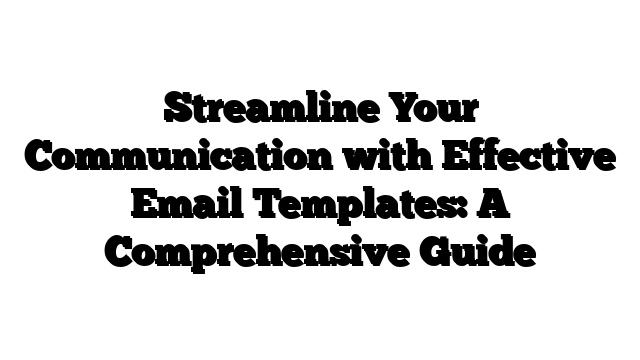In today’s fast-paced digital world, email remains a vital means of communication, both personally and professionally. However, crafting emails from scratch can be time-consuming and inefficient, especially when you find yourself repeating similar messages. That’s where email templates come to the rescue. In this article, we will explore the power of email templates and provide you with a collection of essential headings to make your emails more effective and streamlined.
The Importance of Email Templates: Email templates are pre-designed formats that allow you to quickly compose messages by filling in the necessary details. They not only save time but also ensure consistency and professionalism across your email communications. Whether you’re sending a business proposal, responding to customer queries, or scheduling meetings, email templates can significantly simplify your workflow.
Crafting Effective Email Headings:
- The Subject Line: Grabbing Attention The subject line is the first impression your email makes, and it determines whether your recipient will open it or consign it to the depths of their inbox. A compelling subject line should be concise, clear, and relevant to the content of the email. Use action verbs, urgency, and personalization to capture the recipient’s attention.
- Greeting: Personalize and Engage Start your email with a warm and personalized greeting. Address the recipient by name whenever possible to establish a connection and foster engagement. Tailor your greeting based on your relationship with the recipient, whether it’s formal or informal.
- Introduction: Set the Context Provide a brief introduction that sets the context for your email. Summarize the purpose of your message in a few sentences to ensure clarity and avoid confusion. This helps the recipient understand the email’s relevance and prepares them for the information that follows.
- Main Body: Clear and Concise The main body of your email should contain the key information you want to convey. Use short paragraphs and bullet points to enhance readability. Be clear, concise, and specific in your language. Use a professional and friendly tone, maintaining a balance between being too formal and overly casual.
- Call to Action: Direct and Specific Include a clear call to action (CTA) in your email template. Whether it’s asking for a response, scheduling a meeting, or directing the recipient to a specific resource, make your CTA direct and specific. Clearly state what you expect from the recipient and provide any necessary details or next steps.
- Closing: Professional and Polite End your email with a professional closing that matches the tone of your message. Use phrases like “Sincerely,” “Best regards,” or “Thank you” to maintain a polite and respectful tone. Consider including your contact information or a signature block for easy reference.
Examples of Email Templates with Headings:
- Networking Introduction Subject Line: Introduction and Opportunity to Connect Greeting: Hi [Recipient’s Name], Introduction: I hope this email finds you well. I recently came across your profile on [Platform] and was impressed by your expertise in [Industry/Field]. I wanted to reach out and introduce myself as [Your Name] and explore the possibility of connecting. Main Body: [Briefly introduce yourself and highlight common interests or connections.] Call to Action: I would appreciate the opportunity to have a conversation or grab a coffee to further discuss our shared interests. Please let me know if you’d be available for a brief call or meeting at your convenience. Closing: Thank you for your time, and I look forward to hearing from you soon.
Conclusion: Incorporating email templates into your communication arsenal can significantly enhance your efficiency and effectiveness in email correspondence. By utilizing carefully crafted headings, you can streamline your message, capture attention, and guide recipients through the content of your email. Remember to personalize your greetings, provide context, deliver clear and concise information, include a specific call to action, and conclude with a professional and polite closing.
Email templates not only save time but also ensure consistency in your communications, whether you’re reaching out to potential clients, responding to customer inquiries, or networking with professionals in your industry. By adopting the use of email templates and employing effective headings, you can enhance the professionalism of your emails, improve response rates, and establish stronger connections with your recipients.
Take advantage of the examples provided in this article as a starting point, and customize them to suit your specific needs. Experiment with different subject lines, greetings, and approaches to find what works best for you and your audience. With practice, you’ll become adept at crafting compelling and efficient emails that leave a lasting impression.
So, why spend valuable time and energy drafting emails from scratch when you can harness the power of email templates? Embrace this practical tool and elevate your email communication to new heights of efficiency and effectiveness. Your inbox will thank you, and you’ll find yourself with more time to focus on what truly matters in your personal and professional endeavors.
James Martin is a passionate writer and the founder of OnTimeMagazines & EastLifePro. He loves to write principally about technology trends. He loves to share his opinion on what’s happening in tech around the world.



